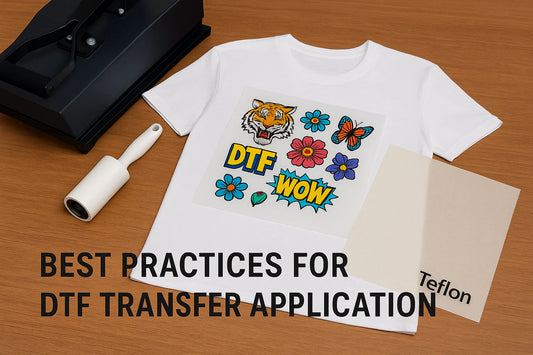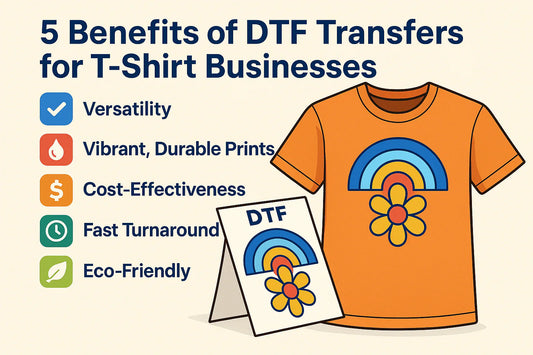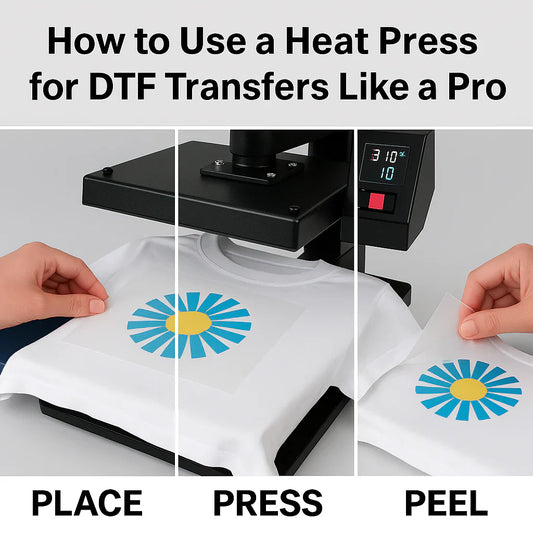What Fabrics Are Best Suited for DTF Printing?
Direct to Film (DTF) Transfers have revolutionized the world of custom designs and heat transfers, offering an incredible range of possibilities for applying images and artwork to various fabrics. But with such versatility, it’s crucial to know which fabrics work best with DTF Transfers to ensure optimal quality and durability. Here’s everything you need to know about choosing the right fabrics for high-quality DTF prints.
What Materials Can DTF Transfers Print On?
DTF Transfers offer broad material compatibility, which makes them an excellent choice for businesses and DIY enthusiasts alike. Unlike some traditional methods, DTF can print on a wide variety of materials, including:
-
Cotton - 100% cotton and cotton blends
-
Polyester - 100% polyester and polyester blends
-
Blends - Cotton-poly blends and other mixed fabrics
-
Nylon - Especially beneficial for jackets and sportswear
-
Silk and Satin - For more delicate designs
-
Linen - Ideal for eco-conscious brands
-
Denim - Common for custom jeans and jackets
-
Leather and Faux Leather - Adds a unique touch to custom designs
-
Canvas - Perfect for tote bags and other accessories
This flexibility allows businesses to use DTF Transfers to create everything from T-shirts to bags, sportswear, and even upholstery with custom designs that are durable and vibrant.
What Fabrics Can Be Printed With Affordable DTF Printers?
Affordable DTF printers today can handle a broad spectrum of fabrics, making DTF Transfers a cost-effective option even for smaller businesses or at-home operations. According to industry statistics, over 85% of DTF-compatible materials include affordable options like cotton, polyester, and blends. Fabrics like cotton and polyester blends are particularly well-suited for DTF printing, providing bright, long-lasting prints. With minimal investment, businesses can enter the DTF printing world and cater to a wide range of fabric-based products.
Choosing the Right Fabrics for DTF Transfers
The right fabric choice can dramatically impact the durability, feel, and appearance of your DTF prints. Here are some of the most popular fabrics for DTF Transfers, based on quality, price, and performance:
-
Cotton - One of the most popular choices for DTF printing due to its high quality and comfort. DTF Transfers adhere well to cotton, resulting in vibrant, high-quality designs.
-
Polyester - Ideal for activewear, polyester provides a lightweight feel and excellent color vibrancy. Polyester fabrics make up approximately 30% of all fabrics printed with DTF Transfers.
-
Blends - Cotton-polyester blends offer the best of both worlds. They balance durability with comfort, often resulting in sharper prints that last through multiple washes.
-
Nylon - Great for jackets and outdoor gear, though it may require special attention to prevent overheating during the transfer process.
-
Silk and Satin - These luxurious fabrics are great for high-end designs, especially for accessories or custom gifts.
Using DTF on these materials, businesses can expect their prints to last up to 50 washes or more without significant fading or peeling, making DTF a reliable option for high-quality heat transfers.
Do DTF Transfers Work on Cotton?
Absolutely! DTF Transfers are highly compatible with cotton, making it a popular fabric for custom T-shirts and other cotton-based apparel. In fact, DTF Transfers work exceptionally well with 100% cotton because the fabric’s natural fibers allow the transfer to bond firmly. This results in vibrant, long-lasting prints that can withstand regular use and washing.
Compatible Fabrics for High-Quality DTF Prints
For high-quality DTF prints, some of the most compatible fabrics include:
-
Cotton: The best for bold, vibrant colors.
-
Polyester: Ideal for sportswear and activewear.
-
Blends: Cotton-poly blends provide durability and comfort.
-
Nylon: Great for outdoor apparel but requires careful temperature management.
Using these fabrics, you can maximize the lifespan and visual appeal of your DTF prints, making your products more attractive to customers seeking both style and durability.
How to Apply DTF Transfers to Different Materials
Each fabric type may require slight adjustments in application to achieve the best results. Here’s a quick guide:
-
Cotton and Blends: Preheat the fabric to remove moisture and then press the DTF transfer at around 300°F (149°C) for 10-15 seconds. Peel hot for best results.
-
Polyester: Lower the temperature slightly to around 275°F (135°C) to prevent scorching, and press for 10-12 seconds. Peel hot.
-
Nylon and Synthetic Fabrics: Use low heat (around 250°F or 121°C) and press for 10 seconds. It’s best to do a cold peel to ensure the transfer bonds correctly.
-
Delicate Fabrics (Silk, Satin): Use low to medium heat and press for a shorter time to avoid damage. Always test on a small area first.
Why DTF Printing Is the Future of Fabric Printing
According to industry experts, DTF printing has seen a growth rate of over 20% annually, largely because it offers high-quality results across multiple fabric types. This method is set to expand as businesses recognize the advantages of DTF Transfers for creating custom designs that are both versatile and durable. The ease of use and broad compatibility make DTF an ideal choice for both small-scale projects and mass production.
Key Takeaways
-
DTF Transfers are highly compatible with a range of fabrics, including cotton, polyester, blends, nylon, and more.
- The affordability of DTF printing makes it accessible for various businesses, enabling high-quality prints across multiple fabric types.
- Cotton, polyester, and blends are the top choices for high-quality DTF prints due to their durability and vibrant results.
- With the right application techniques, DTF Transfers can be applied to different materials easily, making it a flexible and cost-effective solution for custom printing.
Conclusion
Understanding the best fabrics for DTF printing can significantly impact the quality and durability of your custom designs. DTF Transfers offer a versatile and affordable solution for creating vibrant, long-lasting prints on a wide range of materials. Whether you’re working with cotton, polyester, blends, or even delicate fabrics, DTF Transfers allow you to deliver high-quality products that meet customer demands. With this knowledge, you can choose the right fabric for every project, ensuring each print meets the highest standards of quality and durability.
Explore our collection of DTF Transfer options at Sam’s DTF Transfers to start creating custom apparel and accessories that stand out!












0 comments